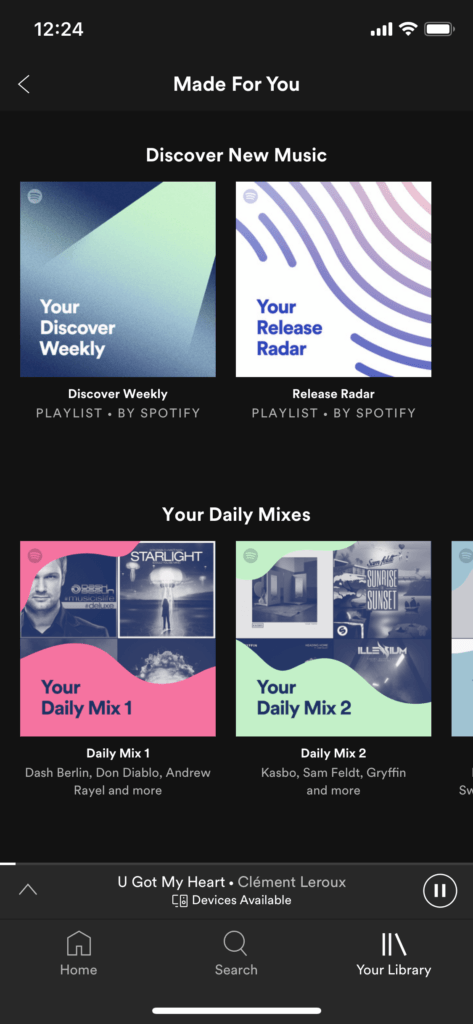How Spotify Beat Apple, Amazon, and Google Using Machine Learning

In an era in which Apple, Amazon, and Google are dominating the technology world, Spotify has succeeded in besting all of them in the music streaming industry. The question is then, how is Spotify able to fend off its major competitors, who are much more established in the technology industry?
 In an era in which Apple, Amazon, and Google are dominating the technology world, Spotify has succeeded in besting all of them in the music streaming industry. Spotify also helped reverse the decade-long secular decline in the global recorded music industry, which declined from $25.2 billion in 1999 to $14.2 billion in 2014[1]. Since 2014, that decline has reversed following the explosive growth of the music streaming industry which grew to $6.6 billion in 2017 to represent 38% of the global recorded music industry[2].
In an era in which Apple, Amazon, and Google are dominating the technology world, Spotify has succeeded in besting all of them in the music streaming industry. Spotify also helped reverse the decade-long secular decline in the global recorded music industry, which declined from $25.2 billion in 1999 to $14.2 billion in 2014[1]. Since 2014, that decline has reversed following the explosive growth of the music streaming industry which grew to $6.6 billion in 2017 to represent 38% of the global recorded music industry[2].
Figure 1 – Global Recorded Music Industry Revenues [Source: IFPI]
The rapid growth in the music streaming industry was driven by Spotify, a global leader with ~42% market share and €4.1 billion revenue in 2017[3]. This was a major feat by Spotify, whose major competitors include technology titans like Apple, Amazon, and Google. Apple Music, Spotify’s nearest competitor, only has approximately half the global subscriber base and market share as those of Spotify[4]. The question is then, how is Spotify able to fend off its major competitors, who are much more established in the technology industry?
One key offering by Spotify is to provide users with machine-generated playlists like Discover Weekly, a personalized playlist with weekly updates. This allows Spotify to differentiate itself, as users who are attracted to these auto-generated playlists choose Spotify over Apple, Amazon, and Google. Machine-generated playlists now represent 31% of all listening activities on Spotify, compared to less than 20% just two years ago, attesting to increasing popularity of such playlists to users[5].
Figure 2 – Spotify’s “Made For You” Playlists and Discover Weekly Playlist [Source: Author]
Spotify primarily uses three machine learning techniques to create tailored playlists[6]:
- Collaborative Filtering: Using user’s streaming history, Spotify recommends songs that different users with a similar streaming history have listened to
- Natural Language Processing: Spotify also navigates the Internet and scans for any text data to gather more information about songs
- Raw Audio Models: Finally, Spotify analyzes the actual audio of songs to identify similar tracks in terms of their sounds. This is especially helpful in analyzing new songs that may not have enough streaming data
Playlists generated by machine learning have become the core of Spotify. Christine Hung, Head of Data Solutions at Spotify, has noted that Spotify has become more than a music streaming service to “a very important platform for [users] to discover something new.[7]”
Arguably, Apple, Amazon, and Google have better machine learning technologies than Spotify, but Spotify’s first-mover advantage and its vast data of streaming history have helped the company remain competitive. To maintain its edge, Spotify should continue to develop its in-house machine learning capabilities and obtain new technologies through acquisitions. “Spotify Machine Learning Day” in July 2018 with experts in machine learning as well as Spotify’s acquisition of a music AI startup Niland in May 2017 are good examples of how Spotify stays ahead of the learning curve. Spotify could even consider partnering with one of the three competitors. The partnership could combine Spotify’s best-in-class machine learning technologies with the competitor’s wide digital distribution network to form a music streaming powerhouse.
One additional way for Spotify to quickly improve its recommendation capabilities is to ask users directly for their preference in music. Currently, Spotify’s recommendation is based on users’ implicit feedback such as stream counts. Users’ explicit feedback, however, can serve as a more accurate indicator of what users want and can significantly improve Spotify’s machine-generated recommendations.
Even though machine learning has been a competitive moat for Spotify, the competitors are catching up fast. How can Spotify better leverage its machine learning technologies to keep the lead in this industry? Spotify has already ventured out to AI-generated music with hiring of François Pachet in 2017, “the world’s foremost scientist in the field of AI-assisted music creation,” but are there any other ways Spotify can use machine learning to offer new services[8]? Also, in what potential areas can machine learning be used for Spotify to engage with the artists directly who would like to place their songs on Spotify?
(Word Count: 797 Words)
[1] International Federation of the Phonographic Industry, “Global Music Report 2018: State of the Industry”, https://www.ifpi.org/downloads/GMR2018.pdf, accessed November 2018.
[2] International Federation of the Phonographic Industry, “Global Music Report 2018: State of the Industry”, https://www.ifpi.org/downloads/GMR2018.pdf, accessed November 2018.
[3] Spotify Technology S. A, March 2018 IPO Prospectus, http://d18rn0p25nwr6d.cloudfront.net/CIK-0001639920/f9537bde-f9af-4553-b0bd-e7421f1f5074.pdf, accessed November 2018.
[4] Morgan Stanley, “Spotify Technology: House Band at a Big Party – Reiterate OW,” May 18, 2018, via Thomson Reuters/Investext, accessed November 2018.
[5] Spotify Technology S. A, March 2018 IPO Prospectus, http://d18rn0p25nwr6d.cloudfront.net/CIK-0001639920/f9537bde-f9af-4553-b0bd-e7421f1f5074.pdf, accessed November 2018.
[6] Sophia Ciocca, “How Does Spotify Know You So Well?,” Medium, October 10, 2017, https://medium.com/s/story/spotifys-discover-weekly-how-machine-learning-finds-your-new-music-19a41ab76efe, accessed November 2018.
[7] O’Reilly Media, “Machine Learning at Spotify: You are What You Stream,” December 7, 2017, https://www.oreilly.com/ideas/machine-learning-at-spotify-you-are-what-you-stream, accessed November 2018.
[8] Music Business Worldwide, “SPOTIFY’S SCIENTIST: ARTIFICIAL INTELLIGENCE SHOULD BE EMBRACED, NOT FEARED, BY THE MUSIC BUSINESS,” January 22, 2018, https://www.musicbusinessworldwide.com/spotifys-scientist-artificial-intelligence-should-be-embraced-not-feared-by-the-music-business/, accessed November 2018.






It is interesting to see the 30% usage of Spotify’s machine-generated playlists; this is indicative of machine learning’s potential to significantly impact the music streaming industry’s profitability. I would be interested to see if there are any layers in the way Spotify’s machine learning technology understands the music taste of its user, especially as streaming has exposed consumers to an increasing variety of genres and music tastes across the world have generally started to converge. Spotify could more accurately recommend playlists for users if it could also account for other external factors, like the user’s time of day and location, that could affect what music the user chooses. Could it also integrate its service with technologies such as Fitbit, which track physical data that could signal the user’s mood? Adding a feedback feature to the songs or playlists suggested, even as simple as a thumbs up or down, could address your point about asking the user for direct input in the music he/she prefers.
As an avid Spotify user, it’s super interesting to get a peek into the way in which the company uses AI to curate my music selections. While I agree that personalization is key to keeping users like me engaged, I’m not entirely convinced that Spotify should continue to develop its in-house machine learning capabilities and obtain new technologies through acquisitions, as you write. Would users truly know the difference between a good recommendation engine and a great one? I’d argue that probably not (or at least not enough to be investing that much more in developing capabilities).
Interesting report, thank you for sharing! I really liked your recommendations. Two things I would add in terms of where they can improve and/or develop are: diversity of selection and live music. For the former, many avid music listeners enjoy being exposed to new music. The risk with AI is that all the recommendations you’re going to see are related to your prior playlists/song selections and the filters you put on. It would be neat to see if spotify could extrapolate other forms of data (such as geography, hobbies, age, etc.) and use that to curate new playlists and suggest songs to try out that you may not have considered listening to. Another idea for connecting artists to consumers would be to actually display live concerts or garage performances.
Thank you very much for your insightful report. The way you address the problem, how Spotify can beat other tech giants, are very interesting. Your report is well equiped with data and also diagram which made me easy to understand your report. While learning your report, I came up with some answers to your question, how Spotify can utilize their data and machine learning to beat other competitors? I think Spotify has a large enough data about the preference of music. When Spotify share the data with Yelp or Google Map, they can understand what kind of person like what kind of music, food, and place to visit, so that they can create an preference recommendation service. For example, by analyzing Spotify data and Yelp data, and analyzing it through machine learning, they can find out the correlation between music preference and food preference, so that they can send a food recommendation and voucher for restaurant, which will enhance the user experience of customers. While there may be a legal issue of sharing individual data, but I believe utilizing preference big data could be one way for Spotify to differentiate from other competitors.